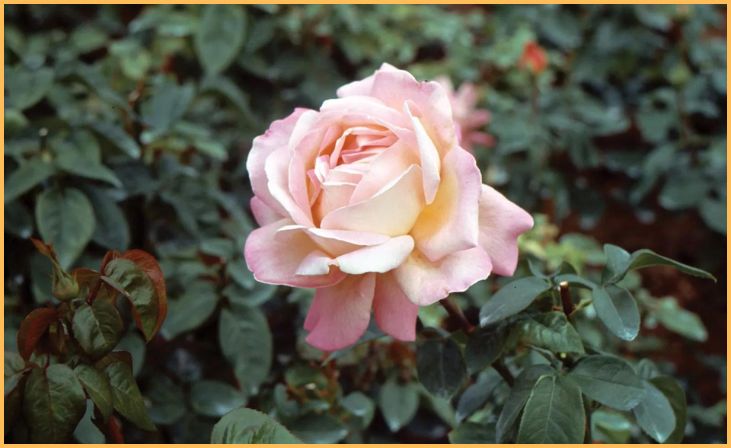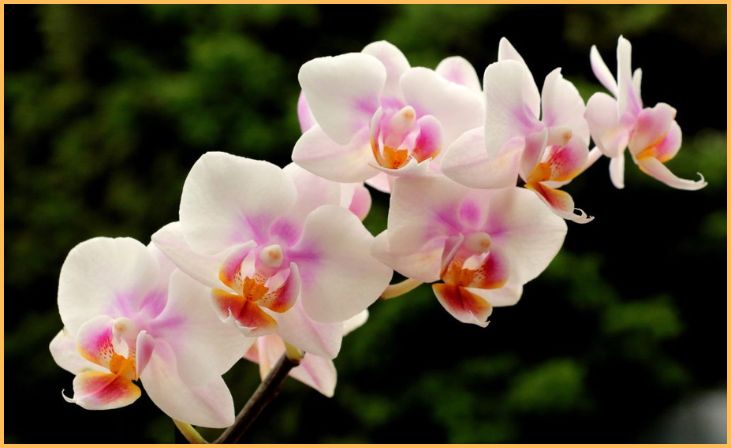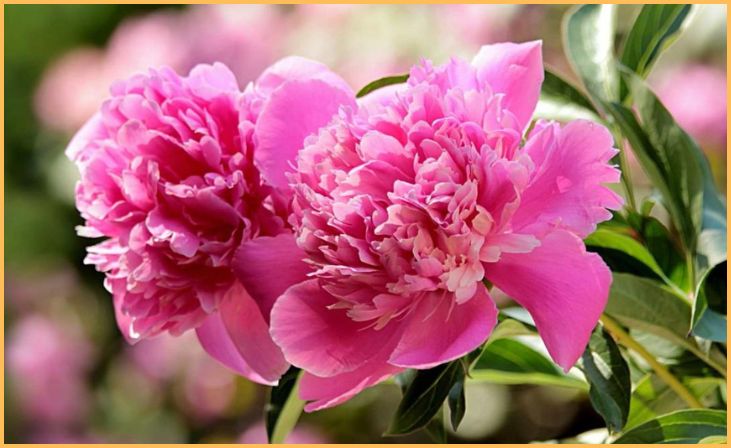Most Popular Types of Flowers – Flowers have held a special place in human culture for centuries, celebrated for their natural beauty, symbolism, and their role in enhancing our surroundings. In gardens, bouquets, and events, these floral wonders are integral to our lives.
This outline delves into some of the most popular types of flowers, exploring their diverse characteristics, meanings, and practical applications.
From the timeless elegance of roses to the vibrant cheerfulness of sunflowers, the delicate charm of daisies, and the exotic allure of orchids, these flowers evoke a myriad of emotions and play essential roles in various cultures, traditions, and industries.
Join us in this exploration of the world’s favorite blossoms, as we celebrate their enduring significance and the joy they bring to our lives.
Importance Of Flowers In Human Culture And Aesthetics
Flowers hold significant importance in human culture and aesthetics for a variety of reasons:
- Symbolism: Flowers often carry deep symbolic meaning in different cultures. They can represent love, beauty, purity, and even specific emotions or sentiments. For example, the rose is a universal symbol of love and passion, while the lotus holds spiritual significance in many Eastern cultures.
- Aesthetics: Flowers contribute to the visual appeal of landscapes, gardens, and interiors. Their vibrant colors, unique shapes, and fragrances enhance the aesthetics of any environment, making them an integral part of interior design, landscaping, and art.
- Cultural Traditions: Flowers are central to various cultural and religious traditions. They are used in rituals, ceremonies, and festivals to symbolize purity, renewal, and devotion. For instance, marigolds are often used in Day of the Dead celebrations in Mexico.
- Expressing Emotions: Gifting flowers is a common way to express emotions. Whether to celebrate an achievement with a bouquet of congratulations, offer condolences with sympathy flowers, or convey affection with a bouquet of roses, flowers serve as a universal language of emotions.
- Healing and Wellness: Flowers have been used in herbal medicine and aromatherapy for their healing properties and therapeutic effects. Lavender, for example, is known for its calming and relaxation-inducing properties.
- Inspiration for Art and Literature: Flowers have inspired countless artists, poets, and writers throughout history. Their beauty and symbolism have been the subject of numerous artworks, poems, and stories.
- Food and Culinary Arts: Some edible flowers, such as roses, violets, and nasturtiums, are used in culinary creations to add flavor and visual appeal to dishes. Flowers are used in salads, desserts, and as garnishes.
- Environmental Importance: Flowers play a crucial role in ecosystems as they attract pollinators like bees and butterflies. This pollination process is essential for the reproduction of many plants and the production of fruits and seeds.
Also, Read – Kitchen Gadgets for Healthy Cooking
Most Popular Types of Flowers
Rose (Rosa)

The rose (Rosa) is an enduring symbol of love and beauty. Its exquisite petals and enchanting fragrance have made it one of the most beloved flowers worldwide. With a rich history spanning centuries, roses are cherished for their elegance and the diverse emotions they convey through their colors.
Red roses signify deep love and passion, while white roses symbolize purity and innocence. These versatile blooms come in various hues, including pink, yellow, and orange, each carrying its own unique significance. Whether as a romantic gift or a gesture of affection, the rose continues to be a timeless emblem of affection and admiration.
Tulip (Tulipa)
The tulip (Tulipa) is a springtime treasure adored for its vibrant colors and graceful, cup-shaped blooms. Originating from Central Asia, these flowers have become a symbol of renewal and love. Tulips are celebrated for their diverse array of colors, from fiery reds and sunny yellows to soft pastels and striking purples.
They bloom in early spring, signaling the end of winter and the arrival of warmer days. Tulips are a favorite choice for gardens and floral arrangements, bringing a sense of cheerfulness and freshness wherever they are found. Their simplicity and elegance make them a popular choice for various occasions, from weddings to simply brightening up spaces with their vivid charm.
Sunflower (Helianthus annuus)
The sunflower (Helianthus annuus) is an iconic symbol of sunshine and positivity. Standing tall with its golden-yellow petals and dark central disc, it radiates joy and warmth. Native to the Americas, these sun-worshipping flowers follow the sun’s path throughout the day, tracking its movement.
Sunflowers embody adoration, loyalty, and a celebration of life. Their large, cheerful blooms brighten gardens and fields, attracting bees and birds with their nectar-rich bounty.
As a versatile bloom, sunflowers are popular for both ornamental and functional purposes, such as providing seeds for snacks and oil production. Their vibrant appearance and the promise of a new day make sunflowers a perennial favorite, spreading happiness wherever they grow.
Also, Read – Outdoor Hobbies for an Active Lifestyle
Daisy (Bellis perennis)
The daisy (Bellis perennis) is a simple yet delightful flower, known for its timeless charm and purity. Its iconic design features white petals surrounding a bright yellow center, resembling a miniature sunburst. Daisies are a symbol of innocence, simplicity, and the beauty of the everyday.
These resilient, low-growing flowers can be found in meadows, gardens, and even growing through cracks in the pavement. Their unassuming beauty carries a message of cheerfulness and the purity of heart. Daisies are often associated with childhood and the idea of young love.
They make for lovely wildflower bouquets and are a reminder that beauty can be found in the most unassuming places, adding a touch of whimsy to the world.
Lily (Lilium)
The lily (Lilium) is a symbol of refined beauty, grace, and purity. With its elegant, trumpet-shaped blossoms and often enchanting fragrance, it stands as a timeless emblem of virtue and sophistication. Lilies come in various forms, including Asiatic, Oriental, and Calla lilies, each possessing its unique charm.
The pure white lily, in particular, is often associated with weddings and symbolizes innocence and purity. Other colors, such as the passionate red and the regal purple, carry their own meanings.
These enchanting flowers are widely used in floral arrangements, gardens, and religious ceremonies, adding a touch of elegance and reverence. Lilies exemplify the timeless allure of the natural world, evoking feelings of admiration and reverence.
Orchid (Orchidaceae)

The orchid (Orchidaceae) is a symbol of exotic beauty and refinement. With thousands of species, orchids boast a stunning diversity of shapes, colors, and patterns, making them some of the most captivating and sought-after flowers. Orchids are often associated with love, luxury, and elegance. They have a mystique that has inspired art, literature, and perfume-making for centuries.
Their alluring appearance and unique adaptations, such as aerial roots and intricate blossoms, have earned them a place of honor in both gardens and homes. Orchids come in an array of colors, from the classic white Phalaenopsis to vibrant Vanda orchids. Their reputation for sophistication and rare beauty makes them a favorite for special occasions and gift-giving, embodying the delicate and exquisite wonders of the natural world.
Lavender (Lavandula)
Lavender (Lavandula) is a beloved herb and flower known for its enchanting fragrance and versatile uses. Its delicate purple spikes not only add a touch of beauty to gardens but also fill the air with a soothing, aromatic scent.
Lavender is celebrated for its calming properties, often used in aromatherapy, perfumes, and herbal remedies to promote relaxation and reduce stress. Beyond its aromatic allure, lavender is a hardy plant with medicinal qualities.
It has been used for centuries to treat various ailments, from insomnia to headaches. The versatile lavender plant thrives in gardens and is a symbol of tranquility, making it a favorite among gardeners and wellness enthusiasts.
Carnation (Dianthus caryophyllus)
The carnation (Dianthus caryophyllus) is a classic and versatile flower appreciated for its ruffled, multi-petaled blooms and sweet fragrance. Available in a wide spectrum of colors, each hue carries its own unique meaning.
For example, red carnations symbolize deep love and admiration, while pink ones express gratitude and white carnations represent purity and innocence. Carnations are popular choices for various occasions, from weddings to Mother’s Day, and they are often used in floral arrangements due to their long-lasting nature.
These resilient and fragrant flowers have a rich history, dating back to ancient times. They are associated with love, affection, and strong bonds, and their timeless appeal continues to make them a cherished selection for expressing emotions and adding elegance to bouquets and corsages.
Also, Read – Best Places to Live in California
Hydrangea (Hydrangea)
Hydrangeas (Hydrangea) are known for their opulent, globe-like blooms and enchanting variety of colors, making them a beloved choice in gardens and floral arrangements. These flowers symbolize heartfelt emotions and gratitude, making them a popular gift for expressing appreciation and understanding.
Hydrangeas come in shades of pink, blue, purple, and white, with the color often determined by the pH of the soil. Their lush, large blooms create a sense of abundance and beauty in gardens and vase displays.
Hydrangeas are versatile and can be used in various settings, from weddings and special events to home landscaping.
Their enduring appeal, with the ability to change colors with soil treatments, adds a unique and captivating dimension to the world of flowering plants, making them a cherished favorite for both gardeners and florists.
Peony (Paeonia)

Peonies (Paeonia) are luxurious and captivating blooms celebrated for their large, ruffled petals and opulent fragrance. Symbolizing romance, prosperity, and good fortune, these timeless flowers have enchanted garden enthusiasts and floral aficionados for centuries.
They come in a wide array of colors, including shades of pink, white, and red, and their lush, full-bodied appearance makes them a favorite for weddings and special occasions.
Peonies evoke a sense of beauty and grace and have been a source of inspiration in art and culture. Their fragrant blossoms are associated with love, happiness, and a bountiful life.
As perennials, they bring joy year after year in gardens, gracing us with their elegance, making them one of the most cherished and enduring symbols of floral opulence and natural beauty.
Conclusion
In conclusion, flowers remain timeless symbols of beauty, emotion, and culture. Their significance in human aesthetics and culture transcends borders, providing a universal language of emotion and aesthetics.
From religious rituals to artistic inspiration, healing properties to economic importance, flowers continue to enrich our lives, reminding us of the profound connection between nature and human expression.
As we appreciate and celebrate their enduring impact, we recognize that flowers will forever hold a special place in the heart of our shared human experience.
FAQs
Flower colors have various meanings. For example, red symbolizes love and passion, while white represents purity and innocence. Yellow often symbolizes friendship and happiness, and purple can signify royalty and admiration.
Roses, particularly red roses, are widely associated with love and romance. They have been a symbol of passionate love for centuries.
Sunflowers symbolize adoration, loyalty, and positivity. They are known for their cheerful appearance and are associated with the sun’s warmth and energy.

